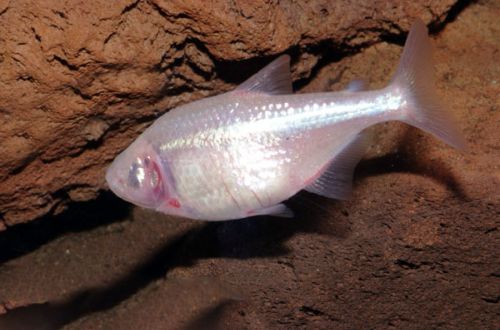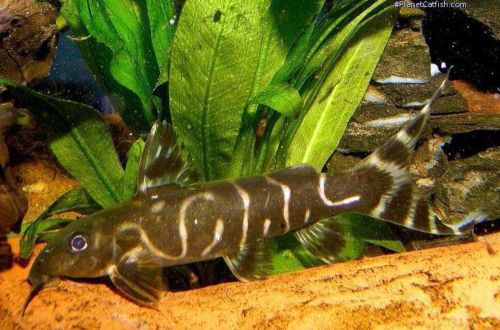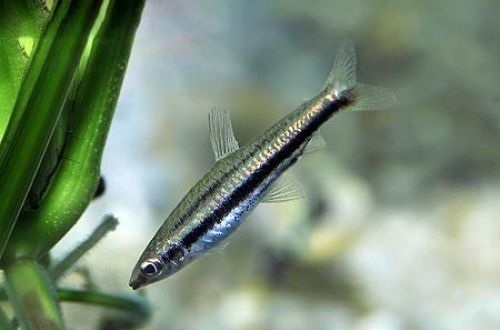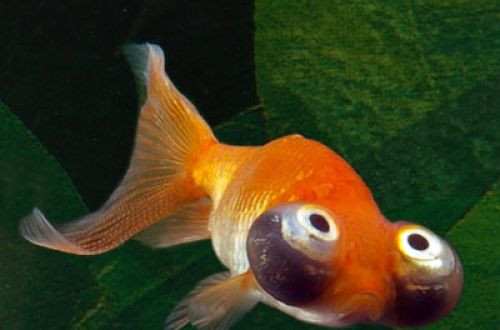
Blind Cave Tetra
The Mexican Tetra or Blind Cave Tetra, scientific name Astyanax mexicanus, belongs to the Characidae family. Despite its exotic appearance and very specific habitat conditions, this fish has gained great popularity in the aquarium hobby. With all its features, keeping it in a home aquarium is very simple and not at all troublesome – the main thing is away from the light.

Contents
Habitat
The blind cavefish lives exclusively in underwater caves in present-day Mexico, however, surface-dwelling closest relatives are widespread in river systems and lakes in the southern United States, in Mexico itself and Guatemala.
Brief information:
- The volume of the aquarium – from 80 liters.
- Temperature – 20-25°C
- Value pH — 6.5–8.0
- Water hardness – medium to hard (12-26 dGH)
- Substrate type – dark from pieces of rock
- Lighting – night illumination
- Brackish water – no
- Water movement – still water
- The size of the fish is up to 9 cm.
- Nutrition – any with protein supplements
- Temperament – peaceful
- Keeping alone or in small groups of 3-4 fish
Description
Adults reach up to 9 cm in length. The coloration is white with transparent fins, the eyes are absent. Sexual dimorphism is pronounced sabot, females are only slightly larger than males, this is especially noticeable during the spawning period. In turn, the terrestrial form is completely unremarkable – a simple river fish.
The two forms of the Mexican Tetra parted ways approximately 10000 years ago when the last ice age ended. Since then, the fish that have found themselves underground have lost most of the pigment, and the eyes have atrophied. However, along with the loss of vision, other senses, in particular the sense of smell and the lateral line, intensified. The blind cave Tetra is able to sense even small changes in water pressure around it, allowing it to navigate and find food. Once in a new place, the fish begins to actively study it, reproducing in memory a detailed spatial map, thanks to which it unmistakably orients itself in complete darkness.
Food
The diet consists of high-quality dry products from well-known manufacturers with the addition of live or frozen food.
Maintenance and care, arrangement of the aquarium
Optimum conditions are achieved in a tank of 80 liters. Decoration is organized in the style of a flooded cave site, using large rocks (for example, slate) in the background and on the sides of the aquarium. Plants are absent. The lighting is very dim, it is recommended to purchase special lamps for night aquariums that give a blue or red spectrum.
Maintenance of the aquarium comes down to weekly replacement of part of the water (10-15%) with fresh and regular cleaning of the soil from organic waste, such as uneaten food residues, excrement, etc.
The aquarium should not be placed in a brightly lit room.
Behavior and Compatibility
Peaceful solitary fish, can be kept in a small group. Due to the nature of the content, it is incompatible with any other type of aquarium fish.
Breeding / breeding
They are easy to breed, no special conditions are required to stimulate spawning. The fish will begin to give offspring quite regularly. In the mating season, in order to protect the eggs on the bottom, you can place a fine-mesh net of transparent fishing line (so as not to spoil the appearance). Mexican Tetras are very prolific, an adult female can produce up to 1000 eggs, although not all of them will be fertilized. At the end of spawning, it is advisable to carefully transfer the eggs to a separate tank with identical water conditions. The fry appear in the first 24 hours, after another week they will begin to swim freely in search of food.
It is worth noting that in the early stages of development, juveniles have eyes that overgrow with time and eventually completely disappear by adulthood.
Fish diseases
A balanced aquarium biosystem with suitable conditions is the best guarantee against the occurrence of any diseases, therefore, if the behavior of the fish has changed, unusual spots and other symptoms have appeared, first of all check the water parameters, if necessary, bring them back to normal, and only then proceed to treatment.





